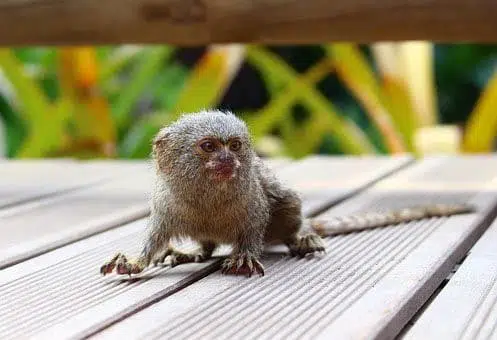Welcome to the Top 10 Small Animals.
There is no doubt that whether it is the mighty elephant or the small animals in the world, if you are an animal lover, you will love them all, great and small. Each of the small animals might not have people coming to see them in safari parks as they do in the Big Five.

But still, they have unbelievable charm and are extremely clever and crafty at avoiding danger and looking after their young!
Let’s look at ten of the small animals in the world in no particular order:
Key Points
| Animal | Description | Size | Weight | Animal Type | Lifespan |
|---|---|---|---|---|---|
| Pygmy Marmoset | World’s smallest monkey, native to South America rainforests. Camouflaged, tree-dwelling, and omnivorous. | 4-6 inches | 100 grams | Mammal | 12 years |
| Pygmy Rabbit | Tiny rabbit species, endangered due to habitat destruction. Prefers sagebrush and is active mainly at dawn and dusk. | 9-11 inches | 0.827 – 1.102 pounds | Mammal | 2-5 years |
| Madame Berthe’s Mouse Lemur | The world’s smallest primate, found in Western Madagascar. Solitary, nocturnal, and primarily fruit and flower eaters. | 4.6 inches | 35 grams | Mammal | 6-8 years |
| Speckled Padloper Tortoise | Smallest tortoise species, native to South Africa. Herbivorous and reclusive, active in the morning. | 2-3 inches | 95 – 160 grams | Reptile | 20-40 years |
| Etruscan Shrew | Tiny mammal known for rapid movements and eating habits. Found in various regions, warm, damp habitats. | 3-5.2 cm | 1.3-2.5 grams | Mammal | Two years |
| Slender Blind Snakes | Thread-like snakes found in various regions, burrowers, and insect eaters. Active at night, solitary. | 4-10 inches | 1.4 grams | Reptile | ± 2-8 years |
| Baluchistan Pygmy Jerboa | Smallest rodent, found in Afghanistan and Pakistan, known for long hops and adaptations to desert life. | ± 1.7 inches | 3.8 grams | Mammal | ± 6 years |
| Northern Pygmy-Owl | Small owl, ferocious hunter, found in North America. Active at dusk and dawn, feeds on various prey. | 16-18 cm tall | 62-73 grams | Bird | ± 6 years |
| Bee Hummingbird | Smallest living bird, found only in Cuba, powerful fliers, feed on insects and spiders, vibrant colors. | 2.4 inches | 2.6 grams | Bird | ± 7-10 years |
| Kitti’s Hog-Nosed Bat | Smallest bat species, found in Thailand and Burma, cave dwellers, feed on insects, and have unique adaptations. | 1.1-1.3 inches | 2 grams | Mammal | 5-10 years |
Overview of Top 10 Small Animals on Earth
1. Pygmy Marmoset
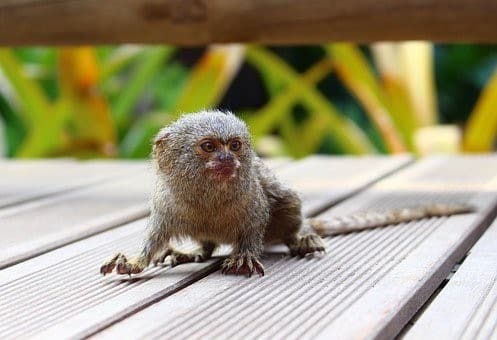
You are not likely to catch sight of these mini monkeys too much. They come from high in the rainforests of South America. They will leap, duck, and dive between the branches of the trees and creepers. Then they will suddenly freeze like a statue and then dash off again, just like a little squirrel.
It also has brown hair, similar to a squirrel, and its tail is much like a squirrel. The color of these marmosets camouflages them so well from their enemies. These little pygmy marmosets are the world’s most miniature monkeys. Actually, when it is fully grown, it will fit into an adult’s hand, and it doesn’t weigh any more than a stick of butter, you could say! Its tail, though, is longer than its body; it’s the tail that helps to give the monkey its balance as it leaps from tree to tree and gallops its way through the trees.
Their homes are in the trees. They also like to live in bamboo thickets along the rivers. They like hiding amongst the growth and foraging from just a few trees around their home. Being so small, they become prey for birds like hawks and eagles, or the cat family, as well as snakes. That’s why they dash from one spot to the next. They like eating nectar and fruit, but when in captivity like in a zoo, they will eat things like mealworms, crickets, hard-boiled eggs, and wax worms.
We have an entire article on the finger monkey.
| Size | 4-6 inches
Tail: 6-9 inches |
| Weight | 100 grams |
| Animal type | Mammal |
| Lifespan | 12 years |
2. Pygmy Rabbit
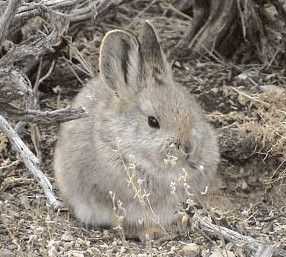
The pygmy rabbit is the smallest in the world! It’s got grey fur and little white spots on its nose. It won’t grow much bigger than a person’s foot and weighs only about one pound. It lives in burrows or near tall grasses and brush. They like the food near them, which is a lot of grass, and they particularly like the sagebrush.
This tiny little rabbit is very rare these days because sagebrush is being destroyed as farms take over. In fact, this little rabbit is now an endangered species.
They are also active in the day, but mainly in the evening and just before sunrise. In the afternoon, they rest near their caves to dive in should danger come. Their main predators are foxes, bobcats, badgers, coyotes, owls, etc.
| Size | 9-11 inches |
| Weight | 0.827 to 1.102 pounds |
| Animal type | Mammal |
| Lifespan | 2-5 years |
3. Madame Berthe’s Mouse Lemur
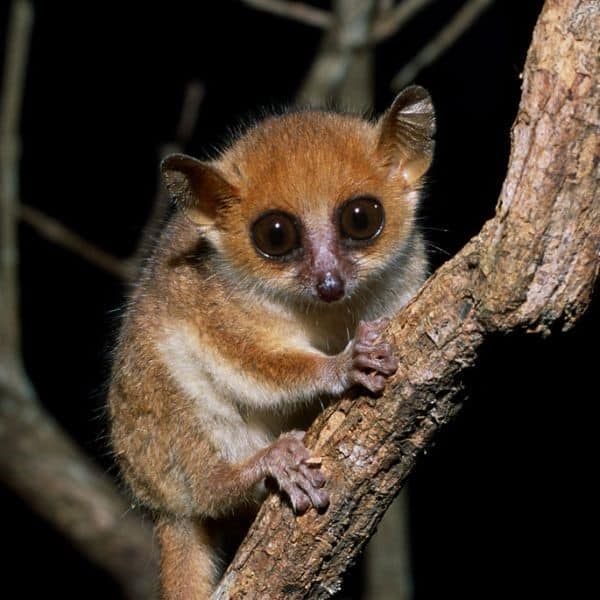
Allow me to introduce you to the endearing Madame Berthe Mouse Lemur, a creature that bears a striking resemblance to a mouse. These pint-sized lemurs boast a charming appearance with their greyish-brown bodies, brown heads, and notably prominent ears. They possess a unique survival strategy, relying on their keen sense of hearing to detect bird alarm calls and signals from other lemurs, helping them steer clear of potential predators. What sets them apart is their remarkable title as the world’s tiniest primates, a distinction that is uniquely theirs, as they call Western Madagascar their exclusive home.
These diminutive lemurs sport a captivating blend of cinnamon and yellow hues, complemented by delicate shades of light grey. Their under-fur boasts a neutral palette of black and grey. It’s worth noting that these remarkable creatures are not found anywhere else on our planet. They lead a solitary existence, primarily active during the cover of night. When daylight breaks, they retreat to nests nestled within trees or cozy holes. During their waking hours, they often engage in grooming rituals or gather together for brief moments of connection.
What truly sets them apart from their lemur counterparts is their resilience to winter. Rather than hibernating, they simply expand their territorial range in search of sustenance when the colder months descend.
Their diet consists mainly of fruits and flowers plucked from various trees and shrubs. In addition to these botanical delights, they indulge in insect secretions, arthropods, gum, and even small vertebrates such as chameleons and geckos. Sadly, the looming threat of deforestation casts a shadow over the future of these precious creatures. If these environmental challenges persist, it’s a grim reality that Madame Berthe Mouse Lemurs could face extinction within a mere decade.
| Size | 4.6 inches |
| Weight | 35 grams |
| Animal type | Mammal |
| Lifespan | 6-8 years |
4. Speckled Padloper Tortoise
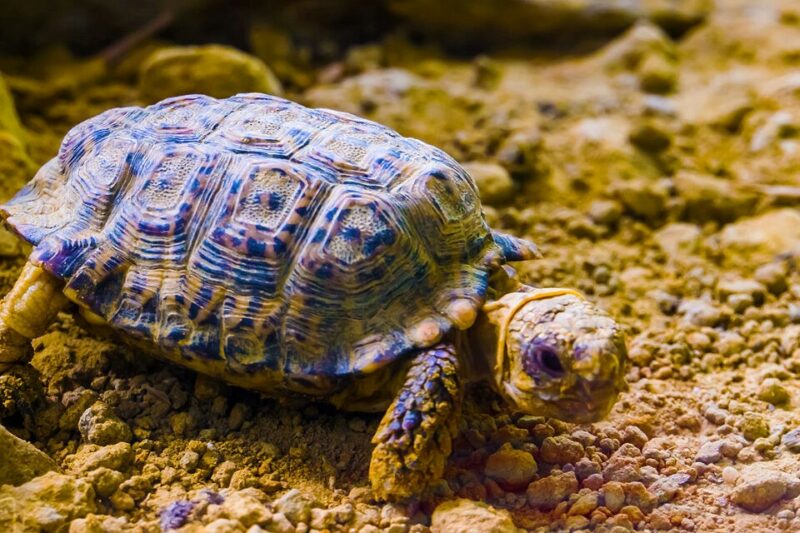
The little Speckled Padloper Tortoise is the smallest in the world and it won’t survive being kept as a pet. Their coloring is goldish-beige and their shell has black spots.
They eat mostly a plant diet. The tortoise is native to South Africa. You can tell this particular species apart from other tortoises in its genus because it has five toes on its forefeet and by its speckles. They live on the rocks and rocky outcrops, foraging for food among the rocks. Then they have the shelter of the rocks from the heat and also from predators.
Herbivores will feed on leaves, flowers, grasses, shrubs, succulents, and forbs. They are reclusive animals and are most active early in the morning.
| Size | 2-3 inches |
| Weight | 95 – 160 grams |
| Animal type | Reptile |
| Lifespan | 20-40 years |
5. Etruscan Shrew
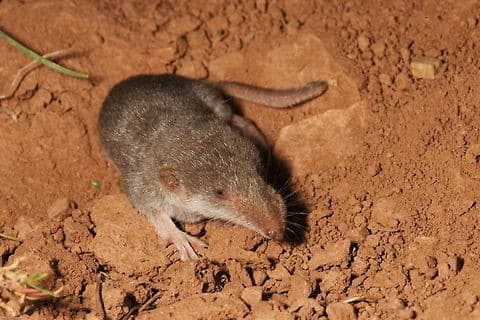
The Etruscan Shrew is the smallest mammal known for its mass. Their main characteristics are their very rapid movements and how they eat so fast. It also eats around 1.5-2 times of its body weight each day. They have a huge head compared to the rest of their body, with small hind limbs.
Their ears are large. The fur close to the body is pale and goes to light-grey on its stomach. It’s got short whiskers near its mouth, which it will use for searching for prey at night. You will find these little animals in Europe and North Africa right up to Malaysia, as well as the Maltese islands. They like warm, damp habitats with shrubs to escape quickly underneath, away from predators.
They make nests in natural crevices and uninhabited burrows and often frequent rocks, boulders, and ruins, darting in and out of them. They are solitary animals.
They are always on the move except when hiding or sleeping. They are most active at night, and they will spend their time near their nest or hiding place during the day. They are omnivores and feed on earthworms, larvae, lizards, rodents, etc.
| Size | 3-5.2 cm |
| Weight | 1.3-2.5 grams |
| Animal type | Mammal |
| Lifespan | Two years |
6. Slender Blind Snakes
Did you know Slender Blind Snakes are also known as worm or thread snakes? They are very smooth and shiny looking. Slender Blinds Snakes are slim, with bodies no wider than 0.2 inches. When you see them moving, they look like pieces of string or thread moving along.
The adult can be around 4 to 10 inches long, and they don’t weigh more than around 0.05 ounces or 1.4 grams in weight. Slender blind snakes are also the only ones with teeth on their lower jaw. They have no teeth on the upper jaw.
Usually, they are just one color, like light to dark brown, grey, or black. Sometimes you get striped ones like the South American ones. These tiny snakes live in Central, South, and North America, but they can appear in Africa and SW Asia, also. They can live in the desert or the rainforests and in rocks.
Whatever the area, they seek slightly more damp conditions because they love to burrow under the soil or hide beneath logs and stones or inside termite hills. They eat small invertebrates such as insects and animals without backbones, like beetles, caterpillars, fly maggots, crickets, cockroaches, spiders, etc. Ants and termites are also on their menu.
| Size | 4 to 10 inches |
| Weight | 1.4 grams |
| Animal type | Reptile |
| Lifespan | ± 2-8 years |
7. Baluchistan Pygmy Jerboa
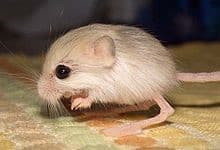
The Baluchistan Pygmy Jerboa is literally the smallest rodent in the world and very cute, even though it looks a little disproportionate. It belongs to around 33 species of the Jerboa, but it is, by the way, the smallest out of all. It is so small it weighs less than an ounce.
Its body length is only around 1.7 inches, without its tail, about 3 inches long. It’s also known as the Dwarf Three-toed Jerboa – this tiny little cotton ball for its head and body, with a little piece of string for its tail! When it stands up, it looks like a tiny little kangaroo as its hind legs are longer than its front legs.
Their feet are disproportionately large compared to the rest of the body. But they jump with long hops and do all their balancing with their tails.
They are to be found in Afghanistan and Pakistan. Some can be found in Northern Africa. They like to live in dunes and gravel. They might resemble kangaroo rats but don’t belong to the same rodent family.
Way back in 1999, this little rodent was recognized by the Guinness Book of Records for being the smallest rodent in the world. They eat seeds blown about by the wind and succulent leaves of the vegetation that grows in the deserts.
They lift their food to their mouths using their tiny little hands. These tiny little rodents have got enemies. They are the leaf-nosed viper, monitor lizards and the sand cats that share their habitat.
Fortunately for them, they jump in all directions, be it vertically, horizontally, or even in a zig-zag manner. This makes them hard to be caught. The Baluchistan Jerboa doesn’t drink water directly to its mouth. Instead, it gets its water from the plants or insects it has eaten.
| Size | ± 1.7 inches |
| Weight | 3.8 grams |
| Animal type | Mammal |
| Lifespan | ± 6 years |
8. Northern Pygmy-Owl
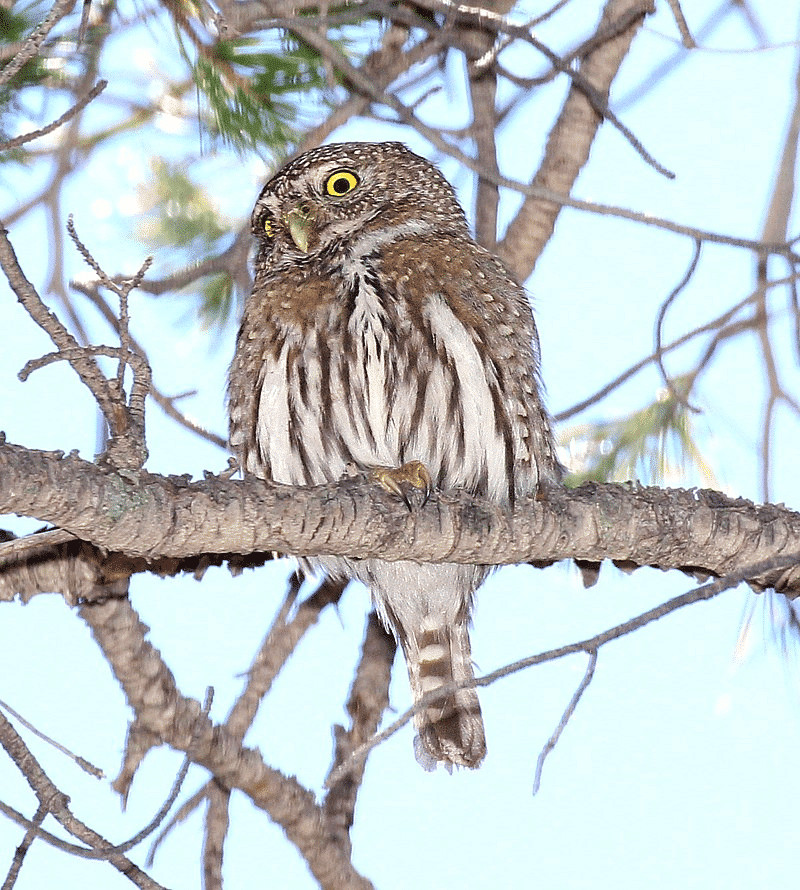
He might be one of the smallest birds in the world, but the Northern Pygmy-Owl is a ferocious hunter. They are known to take the prey, sometimes three times their size.
They are grey or brownish-grey in color. His head has white specks on it. He has yellow eyes and a yellow-green bill. This little owl is found in the USA, Canada, and Mexico.
The Owl loves to live in subtropical and tropical moist forests, wetlands, and savanna. This little owl is active at dusk and dawn. They are secretive, solitary birds. They will sit perched on the top of the trees, giving territorial calls, but they are so hard to see because they are so small – also, their color makes them well camouflaged.
They will swoop down or catch insects in flight when they see prey. The pygmy owls are carnivores. They feed on many small preys, including mammals, giant insects, birds, vertebrates, and invertebrates. They have compelling eye spots on the back of their heads, like eyes, which are believed to confuse them from predators. They hunt during the day.
They might only grow to about 6 inches long, but it doesn’t stop them from taking down good-sized birds and even small mammals like the more giant birds of prey.
| Size | 16-18 cm tall |
| Weight | 62-73 grams |
| Lifespan | ± 6 years |
9. Bee Hummingbird
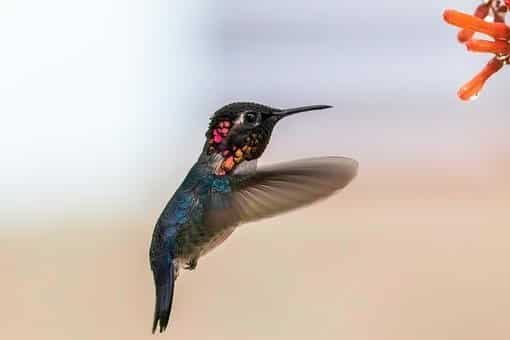
This is the world’s smallest living bird. It might be small, but it is a powerful flier, just like the other hummingbirds are. They eat insects and spiders. If you want to go and find this little bird, you will have to go all the way to Cuba. When you get to the island, your next bet would be to go and search near the forests that have plenty of vines and bromeliads growing on the trees.
If you see flowers, you might find the little Bee Hummingbird. It is only this location – you won’t find it even in groups of other hummingbirds, this minute, exquisite little bird.
After all, it is only about 2 inches long. They are so minute that people often mistake them for bumblebees! Can you believe that! And then they weigh hardly anything, as little as 2 grams.
The tiny little wings will beat around 80 times a second, and when they are courting, those little wings might beat up to 200 times in a second. The male bird has a throat and head of a very bright fiery pink-red color with blazing red feathers that point like spikes down the sides of its breast.
| Size | 2.4 inches |
| Weight | 2.6 grams |
| Lifespan | ± 7-10 years |
10. Kitti’s Hog-Nosed Bat
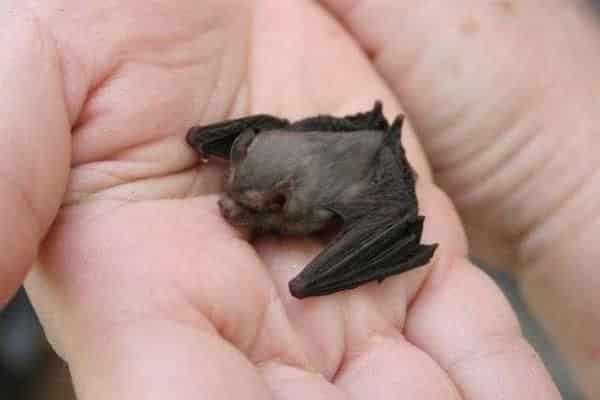
These are also called Bumblebee Bats; that’s how small they are. But they are also the most threatened species of bat. They have tiny little body that is reddish-brown and grey. You will find it living in big colonies, like in a cave where there will probably be more than 100 bats.
Sometimes there can be around 500 bats there. They will roost high up on the walls or roof, far apart. Their eyes are tiny, and the bat is covered with much fur. It has big ears, thin little nostrils, and a nose resembling a little pig.
There is quite a large web of skin between the bat’s back legs, which is said to help it fly and catch insects. But there are no tailbones to help it control its flight. They have large wings that are dark in color. This little bat is found mainly in Thailand and Burma.
They like to inhabit the limestone caves along the river, active in the early morning and dusk. They will have a short activity period, leaving the roost for only about 30 minutes in the evening and early in the morning. If the weather is freezing or there is heavy rain, they won’t come out and fly.
When they forage, they will feed in fields of kapok or cassava or around the bamboo clumps and teak trees not far from their roosting site. Their diet comprises spiders, small flies, beetles, wasps, and lice. Their predators are snakes, birds, cats, and squirrels.
| Size | 1.1-1.3 inches |
| Weight | 2 grams |
| Animal type | Mammal |
| Lifespan | 5-10 years |
Summary of 10 Small Animals
The thing is, these tiniest little creatures are what keep the fabric of our natural work together, but they are oven overlooked. Unfortunately, the stewardship from humans to these little highly-necessary creatures has been anything but successful.
We have become oblivious to these tiny animals’ roles and often forget that once they’re gone, many plants will also go extinct. Fortunately, some conservationists have started to develop strategies to maintain these natural processes and keep them intact.
Time is short to start putting in these strategies to conserve our animals; it’s not a luxury into the future. It’s a necessity. Before you go, look at this post for the top 10 cave animals in the world.
- Animals and Wildlife in Colorado - April 24, 2024
- Best Places to see Sloths - April 24, 2024
- Where to See Alligators in the Wild - April 24, 2024

